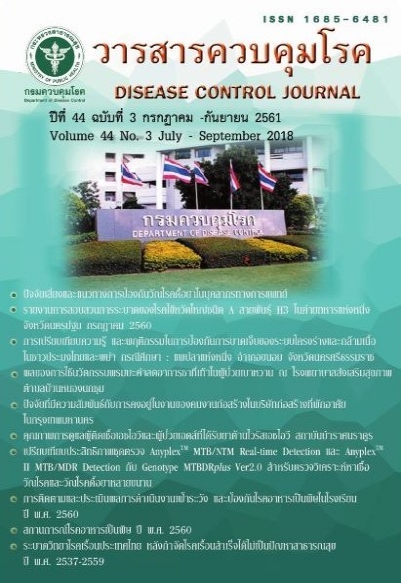Quality of care for people with HIV infection and AIDS receiving antiretroviral therapy in Bamrasnaradura Infectious Diseases Institute
DOI:
https://doi.org/10.14456/dcj.2018.26Keywords:
quality of care, process quality of care, outcome quality of care, people with HIV infection and AIDS receiving antiretroviral therapyAbstract
This descriptive research aimed to study the quality of process and outcome of care for people with HIV infection and AIDS (PHA) receiving antiretroviral therapy (ART) in Bamrasnaradura Infectious Diseases Institute, Nonthaburi Province, Thailand. The 249 medical records were selected with simple random sampling method from the records of PHA who were new cases starting ART during October 2014 – September 2016. Research instruments included patient information form, care-process quality record form, and care-outcome quality record form. Data were collected from the medical records and were analyzed by descriptive statistics, Friedman test and Wilcoxon-signed rank test. Research results related to the quality of care-process revealed that 85.7% of PHA received ARV knowledge and 100% of PHA counseling to prepare for starting ART. They were advised to disclose their infection to their partners and to have family–planning for 53.0% and 39.4% respectively. The quality of care-process during ART was as follows: 95.2% of the PHA were followed up for drug adherence and 78.8% received information about taking antiretroviral drugs (ARV). They were regularly screened for opportunistic infections, comorbidity and sexually transmitted diseases (STDs) for 98.0%, 97.6% and 95.2% of them respectively. 94.8% were assessed for sexual risk behaviors of STDs and 94.0% were advised to have safe sex. They were also assessed for risk behaviors such as alcohol consumption/smoking and drug addiction for 53.8% and 0.8% of them respectively. Most of them (90.8%) were regularly assessed for health problems and those who had health problems were sent to specialist for consultations. Regularity of investigation on CD4 every 6 months and viral load once a year was observed in 90.0% and 35.7% of cases respectively. For the quality of care-outcomes, it was found that drug adherence rate was 91.2%, while 55.8% of the PHA were consistently assessed as good drug adherence (≥95%), 47.0% had regular follow-up and 8.4% were founded to have ARV drug resistance. CD4 levels after ART were significantly higher than those prior to the therapy and viral load levels significantly decreased after ART. The study recommends the development of the care system to increase follow up rate and increase assessment of ART effectiveness as indicated.
Downloads
References
2. World Health Organization. Data and statistics [Internet]. 2017 [cited 2018 Jan 10]. Available from: http://www.who.int/hiv/data/en/
3. สำนักระบาดวิทยา กรมควบคุมโรค. รายงานสถานการณ์ผู้ป่วยเอดส์ในประเทศไทย ณ วันที่ 31 ตุลาคม 2560 [อินเทอร์เน็ต]. 2560 [สืบค้นเมื่อ 10 ม.ค. 2561]. แหล่งข้อมูล: http://www.boe.moph.go.th/report.php?cat=19
4. สุคนธา คงศีล, สุขุม เจียมตน, กนกศักดิ์ วงศ์เป็ง, เพชรัตน์ ศิริสุวรรณ, วรรณี ชัยศิริเพ็ญภาค, อุษา โถหินัง, และคณะ. โครงการผลลัพธ์ทางสุขภาพจากการให้ยาต้านไวรัสเอดส์ ภายใต้ระบบบริการสุขภาพในประเทศไทย. กรุงเทพมหานคร: สำนักงานวิจัยเพื่อการพัฒนาหลักประกันสุขภาพไทย; 2553.
5. ศูนย์พัฒนาระบบบริการยาต้านไวรัสสําหรับผู้ติดเชื้อเอชไอวีและผู้ป่วยเอดส์ในประเทศไทย กรมควบคุมโรค. แนวทางการตรวจวินิจฉัยและการดูแลรักษาผู้ติดเชื้อเอชไอวีและผู้ป่วยเอดส์ระดับชาติ ปี พ.ศ. 2557. กรุงเทพมหานคร: ชุมนุมสหกรณ์การเกษตรแห่งประเทศไทย; 2557.
6. สถาบันบำราศนราดูร. รายงานประจำปีสถาบันบำราศนราดูร 2554. กรุงเทพมหานคร: ชุมนุมสหกรณ์การเกษตรแห่งประเทศไทย; 2555.
7. จุฑาภรณ์ กัญญาคำ, ธนนรรจ์ รัตนโชติพานิช, อรอนงค์ วลีขจรเลิศ, เบญจพร ศิลารักษ์. คุณภาพบริการดูแลรักษาผู้ติดเชื้อเอชไอวีและโรคเอดส์ : กรณีศึกษาในโรงพยาบาลชุมชน จังหวัดร้อยเอ็ด. การประชุมวิชาการและการนำเสนอผลงานระดับชาติ the 4th annual northeast pharmacy research conference of 2012: Pharmacy profession in harmony; วันที่ 11-12 กุมภาพันธ์ พ.ศ. 2555. คณะเภสัชศาสตร์ มหาวิทยาลัยขอนแก่น. ขอนแก่น: คณะเภสัชศาสตร์ มหาวิทยาลัยขอนแก่น; 2555.
8. อุดม กรมโยธา. การประเมินคุณภาพการดูแลรักษาผู้ติดเชื้อเอชไอวีและผู้ป่วยเอดส์ด้วยโปรแกรม HIVQual-T โรงพยาบาลระนอง จังหวัดระนอง ปีงบประมาณ 2558. วารสารเครือข่ายวิทยาลัยพยาบาลและการสาธารณสุขภาคใต้ 2559;3:70-84.
9. Donabedian A. The quality of care: How can it be assessed?. JAMA 1988;260:1743-8.
10. สำนักโรคเอดส์ วัณโรค และโรคติดต่อทางเพศสัมพันธ์ กรมควบคุมโรค. ตัวชี้วัดของ HIVQUAL-T เวอร์ชั่น 5 [อินเทอร์เน็ต]. 2553 [สืบค้นเมื่อ 5 ก.ค. 2560]. แหล่งข้อมูล: http://www.cqihiv.com/Indicators.aspx
11. Rehm J, Probst C, Shield KD, Shuper PA. Dose alcohol use have a causal effect on HIV incidence and disease progression? A review of the literature and modelling strategy for quantifying the effect. Popul Health Metr 2017;15:1-7.
12. ปวีณา สนธิสมบัติ, สุทธิพร ภัทรชยากุล, ชาญกิจ พุฒิเลอพงศ์, ปรีชา มณฑกานติกุล, วิชัย สันติมาลีวรกุล, อรรณพ หิรัญดิษฐ์. คู่มือสำหรับเภสัชกร การดูแลผู้ติดเชื้อเอชไอวีและผู้ป่วยเอดส์. กรุงเทพมหานคร: ประชาชน; 2554.
13. Foisey M, Tseng A. Interactions between opioids and antiretrovirals [Internet]. 2014 [cited 2018 Mar 15]. Available from: www.hivclinic.ca/main/drugs_interact_files/narc-int.pdf
14. Soeters HM, Napravnik S, Zakharova OM, Eron JJ, Hurt CB. Opportunities for sexual transmission of antiretroviral drug resistance among HIV-infected patients in care. AIDS 2013;27:2873-81.
15. Meresse M, March L, Kouanfack C, Bonono R-C, Boyer S, Laborde-Balen G, et al. Patterns of adherence to antiretroviral therapy and HIV drug resistance over time in the Stratall ANRS 12110/ESTHER trial in Cameroon. HIV Med 2014;15:478-87.
Downloads
Published
How to Cite
Issue
Section
License
Articles published in the Disease Control Journal are considered as academic work, research or analysis of the personal opinion of the authors, not the opinion of the Thailand Department of Disease Control or editorial team. The authors must be responsible for their articles.






